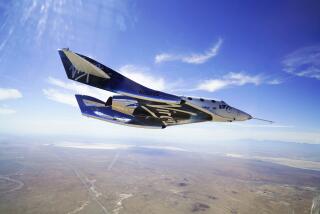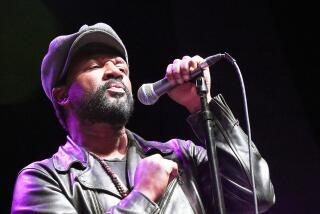Virgin America wins accolades but finds profits elusive
- Share via
Even by the standards of today’s economy, Virgin America’s financial health seems pretty weak: While enjoying a hip, high-tech reputation, the San Francisco airline has reported only one profitable three-month period since it launched nearly five years ago.
If the airline’s executives are worried, they aren’t showing it. In fact, they continue to hire at a brisk pace — 500 workers last year — and, at a time when other airlines are cutting back, they have added routes on a regular basis. They say they are laying the groundwork for a money-making airline.
“We are happy with the trajectory it’s going,” said billionaire Richard Branson, founder of the Virgin Group, a minority share owner in the privately held airline. “If we wanted to make profits, we would stop expanding.”
Then again, the nation’s only major California-based airline has never followed a traditional path.
Only a few months after launching in 2007, the airline held a Victoria Secret fashion show onboard a flight from Los Angeles to New York. Since 2010, the airline has teamed up with animal shelters in San Francisco to fly about 200 homeless Chihuahuas to New York to get them adopted by apartment dwellers in the Big Apple.
Virgin America is also the first U.S. airline to install power outlets near every seat and equips every cabin with soft lighting that changes from pink to blue to purple, based on the time of day.
It’s a cool and hip style that has won over many young devoted passengers and helped beat out bigger and more established airlines for top awards from Conde Nast Traveler and Travel & Leisure magazines over the last four years. The airline’s loyal customers, however, were quick to jump on Facebook to complain last fall when its reservation system went haywire.
But analysts wonder when such accolades will produce steady profits.
“It’s kinda time for them to start making money,” said Seth Kaplan, a managing partner at Airline Weekly, a trade publication.
Then again, other industry experts say, the upstart airline could be a gamble that is about to pay off big.
“With the established airlines cutting capacity, they might be filling a void,” said Betsy Snyder, an airline analyst with Standard & Poors. “People who have flown them say they have a great product.”
From the beginning, the airline faced strong head winds.
Virgin America, launched in August 2007, was envisioned as a low-cost airline with high-tech amenities, such as a touch-screen entertainment system, wireless Internet and cabins with soft mood lighting. Branson’s Virgin Group holds 25% of the airline’s voting stock, with VAI Partners, a consortium of U.S. investors, holding 75%.
Virgin America’s main hub is San Francisco International Airport, but the airline is not limiting itself to the West Coast.
Today, the airline has 2,200 employees and serves 16 airports in the U.S. and Mexico, adding the newest destination, Palm Springs in December. Although the airline fits the technical definition of a low-cost airline, its fares are often beat by its bigger competitors.
“Our reason for starting Virgin America was the lack of quality in the country’s airlines,” Branson said.
But Virgin America’s business plan put it in direct competition with low-cost carriers like Southwest Airlines and JetBlue, as well as major network carriers. Nearly 80% of Virgin America’s routes now overlap those of major airlines like United Air Lines and American Airlines.
“I don’t see them growing to overtake Southwest,” said George Hobica, founder of the travel website Airfarewatchdog, “but they’re definitely causing angina for JetBlue in some markets.”
New York-based JetBlue shrugs off such talk.
“Virgin America’s impact has not been greater than our expectations, and based on the consistent growth of our customer base in the market, JetBlue’s award-winning service and superior product are preferred among L.A. travelers,” JetBlue spokeswoman Alison Croyle said.
But the carrier’s business plan grew even tougher as jet fuel prices climbed from about $1.20 per gallon in 2004 at the time Branson drew up the plans to launch Virgin America, to $2.90 a gallon in December.
Virgin America reported its first profits — $5.1 million — for the July-through-September period in 2009. It has operated in the red ever since. In its most recent earnings report, the airline reported a net loss of $3.3 million for the July-through-September period of 2011.
But Virgin America’s chief executive, David Cush, rejects comparisons with older airlines that are not saddled with the expenses of adding staff and routes. In 2011, he said, the airline increased its capacity about 35%.
“We are building a critical mass of a route structure,” he said. “That puts a lot of stress on revenue.”
The airline has also been dogged by growing pains.
Since late October, glitches in a new reservation system have prompted angry passengers to fill Virgin America’s Facebook page and Twitter account with complaints.
“As a loyal customer from the very beginning, I can not adequately express my frustration with my experience today,” a longtime passenger wrote on Facebook in November. “After waiting 50 minutes and hanging up, I called back and am currently on hold for over an hour.”
Cush said the reservation problems have been fixed. “We knew it would take a couple of months to work out the kinks,” he said. “Unfortunately, it comes with the territory.”
But Virgin America also has many loyal fans who rave about the cabin lighting, touch-screen entertainment system and onboard food service. The airline was the first in the nation to offer wireless Internet throughout its fleet. It plans to upgrade the onboard Wi-Fi, to quadruple its speed and capacity, starting early this year.
“Virgin America has a great attitude and aesthetic, and so far everything has been kept clean and shiny,” said Laura Anne Edwards, the president of a Santa Monica media company who has flown Virgin America since it launched.
Based on fare comparisons for flights between several popular routes, Virgin America’s prices are often on par or $20 to $30 higher than those of Delta, American and United airlines.
The challenge for Virgin America, analysts say, is to continue to attract more passengers willing to spend a few extra dollars for the airline’s in-flight amenities and cool lighting.
Ray Neidl, an airline analyst for the New York wealth management firm the Maxim Group, said he was impressed with the airline’s service and technology when he flew Virgin America for the first time in December.
“The big question,” he said, “is can they carve out a market share with big profits and a unique product?”
More to Read
Inside the business of entertainment
The Wide Shot brings you news, analysis and insights on everything from streaming wars to production — and what it all means for the future.
You may occasionally receive promotional content from the Los Angeles Times.










